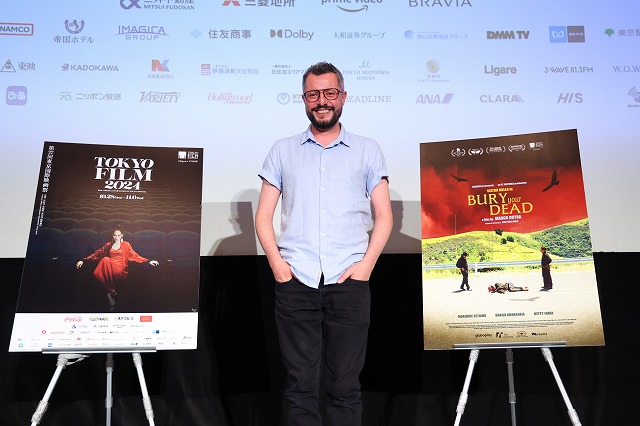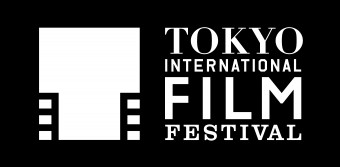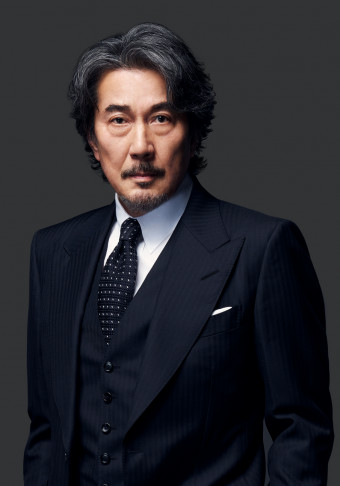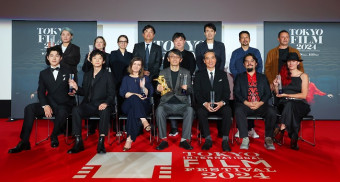
Stop me if you’ve heard this one: a priest and a murderous cynic walk into a bar… That’s sort of the basic premise of Brazilian director Marco Dutra’s offbeat and purposely convoluted apocalyptic black comedy Bury Your Dead, which screened for the second time on November 2 in the Competition section of the 37th Tokyo International Film Festival. Though Dutra was unable to attend the Asian Premiere of his movie earlier in the week, he was visibly stoked to be taking questions after the second screening. “I just want to say how happy I am to be here. I’m on the verge of tears, since it’s always been my dream to come to Japan, and after 37 years that dream has finally come true.”
The audience seemed stoked, too, a natural reaction to Dutra’s movie, which approaches the end of the world as a kind of cosmic joke that the characters are only partially in on. The protagonist, Edgar Wilson (Selton Mello), is a dour, difficult-to-read civil servant who cleans up roadkill on Brazil’s highways. The fact that there is a civil service exclusively dedicated to roadkill quickly clues the viewer in to the particular nature of this apocalypse, which is also characterized by pink rocks falling randomly from the sky and the emergence of a religious sect led by evil children.
Edgar’s cowboy-hatted sidekick, Tomás (Danilo Grangheia), is a priest who’s been excommunicated for killing someone and now carries out exorcisms-for-hire. The third main character is Edgar’s girlfriend and dispatcher Nete (Marjorie Estiano), who is joining the doomsday cult for family reasons and wants Edgar to join as well. Given Edgar’s attitude toward everything, you can imagine how successful she is.
TIFF’s moderator for the Q&A session, Yasuda Yuko, rightly pointed out that the film, though strong in plot and structure — it’s based on a novel — is filled with “enigmas and questions and emotions” that are all blended together in disarming ways, and wondered what the reaction was when it was screened at other film festivals in South America and Europe.
“The reaction is always different,” said Dutra. “I think you can only understand the film when you show it to an audience. The response is important to me because I don’t really understand it myself. In fact, it requires a response.” If the answer sounds as enigmatic as the movie, Dutra pointed out that it has a lot to do with his filmmaking process.
One of the audience members, who herself is from Brazil and has seen Dutra’s earlier films, asked him why he splits his filmography between collaborative directing productions and solo projects. The director answered that it has much to do with his education as a filmmaker. “When I went to film school, I met a lot of the people I still work with, because in school we usually took on specific roles to make a film in order to gain experience. Naturally, we continued doing that after we graduated and started making our own films.”
He went on to explain how when one of their clique had an idea they all pitched in to make that idea into a film. “It’s always better to have partners,” he said. “But sometimes you have an idea that you think you can do by yourself, like this one.”
This singularity of vision made itself apparent to one audience member who asked about a scene in which a character dies dramatically and Dutra captures it with a very shaky sideways tracking shot. “That death is right at the midpoint of the story,” said the director, “and while the narrative is linear, the visuals are geometric. I’d been traumatized by computer special effects in earlier films and I wanted to stick to natural effects in this one.” In essence, his crew set up a smooth tracking shot for the death scene, but Dutra, who was shooting the scene in an abandoned railway yard, rejected it for something more unsettling by putting the camera in an old handcar on available railroad tracks. “I was very happy with it, but my crew wasn’t, though later, after seeing the finished product, they liked it.”
Another audience member who raved about the originality of the film nevertheless wondered about some of the comic elements, especially Dutra’s use of the Titanic theme song, “My Heart Will Go On” in a pivotal scene. “That song wasn’t in the book,” he said. “I put it in myself. I saw the movie when I was ten and taking piano lessons [Dutra also provided the score for his film] and learned how to play that song. Later, when I read that romantic scene where one of the characters plays the piano, I thought it would be perfect for her to play ‘My Heart Will Go On’ because Titanic is full of death and tragedy. I wanted her to use the song to refer to her grief.” He added that securing the rights to the song was the most difficult part of the post-production process. “It took me a full year, but I finally got the rights.”
As another kind of cosmic joke, Yasuda asked which character in the film the director most closely identified with. Without hesitation he said, “Tomás. Because he always knows what’s going to happen in the future, as if he were the screenwriter. Also, he’s an outcast trying to figure it all out, trying to stay one step ahead of everyone else,” which, of course, is one way to describe what a movie director does.
Q&A Session: Competition
Bury Your Dead
Guests: Marco Dutra (Director/Screenplay/Composer)


























































